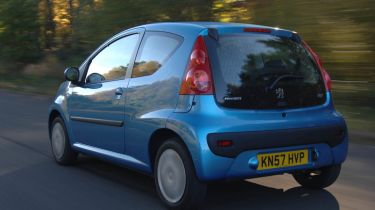Peugeot 107 Urban
Youthful appeal makes the French hatch an attractive proposition
As city cars go, the 107 has near-perfect dimensions. Short overhangs and great all-round visibility make nipping in and out of traffic a breeze, while the vertical tail means reverse parking is trouble-free. Style has not been sacrificed, though – in fact, along with its Toyota Aygo and Citroen C1 cousins, we think the 107 is one of the best-looking small cars around.
The angled headlights echo those on the larger 407 family car and give the Peugeot a neat nose, while the triangular rear clusters are a nice touch. The funky lines will doubtless appeal more to younger buyers than the Picanto’s.
This unique style applies to the interior, too. While the Kia has a grown-up feel, the French car is more distinctive. With unusual heater controls that glow orange at night, as well as a user-friendly stereo and a pod-style speedometer, the design is fresh and attractive. There are some exposed bolts on the doors, but they fail to spoil the appearance of the cabin.
Despite an overall length of less than 3.5 metres, the 107 provides plenty of space for occupants in the front – although knee room can feel a little restricted, and there’s no height adjustment on the seats. They’re quite narrow and flat, too, but are surprisingly comfortable, even on longer journeys.
Used - available now

2022 Mercedes
GLC
35,992 milesAutomaticDiesel2.0L
Cash £27,300
2023 Peugeot
208
19,061 milesManualPetrol1.2L
Cash £14,752
2018 Volkswagen
Scirocco
70,657 milesManualPetrol1.4L
Cash £10,350
2021 Ford
Fiesta
23,384 milesManualPetrol1.0L
Cash £12,495Rear passenger space is adequate, although taller people will find legroom is tight, and stowage is compromised by the fact that the speakers take up most of the space in the door pockets. We’re using a three-door model for our pictures – the five-door variant gets pop-out rear windows, yet they are fiddly to use and offer little ventilation. Overall, the interior is best summed up as basic but stylish.
And this spartan approach helps keep weight down. At 825kg, it’s more than 100kg lighter than the Kia. That low figure is helped by the featherweight 998cc engine, which tips the scales at only 67kg. It produces 68bhp, and with its characterful exhaust note and three-cylinder thrum is great fun to use, delivering sprightly performance.
Good throttle response and a positive five-speed gearbox help, and at the test track the 107 completed the 0-60mph benchmark in 12.8 seconds – one second faster than the Kia. As with the Picanto, the 50-70mph in-gear time was very slow at 23.5 seconds. The 107 is easy to drive, though, thanks to a light clutch and gearshift, while the vibration from the three-cylinder engine is well insulated.
This makes it more refined around town than the Kia. In fact, even at motorway speeds it’s well mannered and will happily cruise at 70mph. Despite its weight and size, the 107 is stable, too, which is helped by a relatively wide track. This boosts the handling, and with go-kart like reactions and responsive steering the Peugeot is nimble and sure-footed through bends. The ride quality could be improved, but it deals with rough urban roads better than its rival and doesn’t crash over potholes.
One area in which it can’t compete with the Kia is price. Our Urban variant is the cheapest five-door 107 available, yet still costs £7,905 – nearly £1,000 more than its Korean rival. For buyers who want extra equipment, the Peugeot does have a longer options list, with alloy wheels, stability control and even a TomTom sat-nav unit available. But these will set you back extra, and in standard guise kit levels aren’t as generous as in the Picanto.
Details
Price: £7,905
Model tested: Peugeot 107 Urban
Chart position: 1
WHY: The funky 107 is a great city car that will provide a tough challenge to the fresh Picanto.
Economy
Even though it’s more powerful, the 107 is lighter, and so returned a better 46.5mpg with us. Yet that is still some way short of the claimed 61.4mpg economy figure.
Residuals
A trendy image and relatively cheap insurance help the 107 appeal to young drivers. And that partly explains its strong residual value figure, at 48.4 per cent.
Servicing
Peugeot charges £610 for three services on the 107. It has twice as many dealers as Kia, but its network was voted a lowly 28th in Driver Power 2007.
Tax
The 107’s price counts against it. Both cars fall in the 15 per cent tax bracket, but lower-band business drivers pay £261 a year – £30 more than those who choose the Kia.







